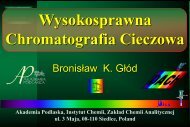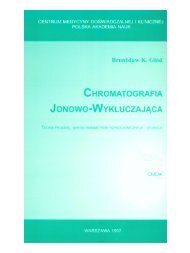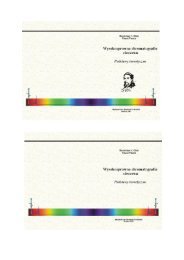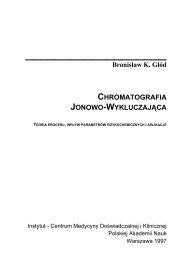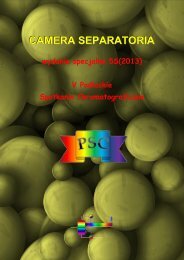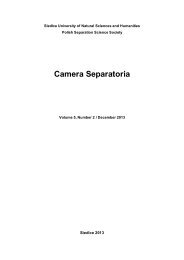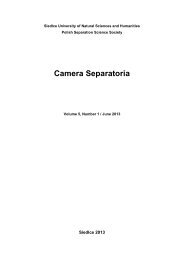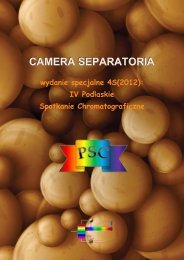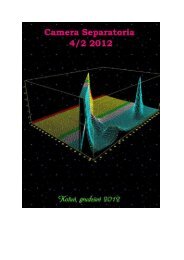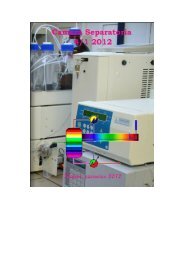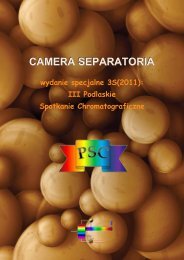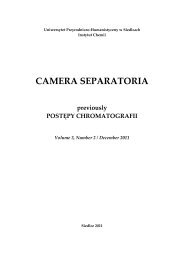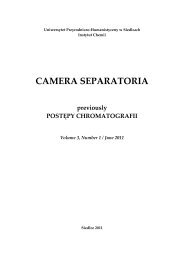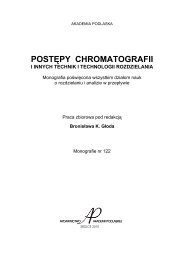CamSep 2 S
Create successful ePaper yourself
Turn your PDF publications into a flip-book with our unique Google optimized e-Paper software.
FAST SCREENING OF LIPIDS AND RELATED NON-POLAR<br />
SUBSTANCES FROM BIRDS’ FEATHERS AFTER MICRO-TLC<br />
SEPARATION<br />
Michał J. BARAN, Paweł K. ZARZYCKI<br />
Section of Toxicology and Bioanalytics, Koszalin University of Technology, Sniadeckich 2, 75-453<br />
Koszalin, Poland; E-mail address: pkzarz@wp.pl<br />
Bird’s feathers are often considered as convenient samples for non-destructive environmental<br />
biomonitoring of organic pollutants or raw material for birds chemotaxonomy studies [1]. From<br />
analytical point of view planar chromatography fractionation has a great potential as the initial<br />
examination tool of such complex raw samples, particularly, taking into account fast and efficient<br />
multidimensional separation and sensitive detection of UV-Vis transparent chemicals via common<br />
visualization agents including iodine or phosphomolybdic acid (PMA) [2]. Main goal of this<br />
research communication is to demonstrate capability of micro-TLC methodology [3] for fast<br />
separation and quantification of wide range non-polar chemicals that are present on the birds’<br />
feathers surface. Designed analytical protocol involves simple liquid extraction using<br />
dichloromethane/methanol mixture, direct sample application on TLC RP18 micro-plates,<br />
separation using binary organic solvent mobile phase composed of dichloromethane/methanol<br />
(developing distance 45 mm) and detection including PMA and iodine chemicals (Fig.1 A and B).<br />
Mobile phase optimization data has revealed that micro-TLC separation and quantification protocol<br />
can be successfully applied for fast screening of lipids and related non-polar substances from birds’<br />
feathers or uropygial gland secretion products.<br />
Fig. 1. Micro-chromatogram (A) and densitogram corresponding to lane No 3 (B) of raw samples<br />
derived from bird feathers and fatty oils.<br />
References:<br />
[1] V.L.B. Jaspers, A. Covaci, P. Deleu, M. Eens, “Concentrations in bird feathers reflect regional contamination with<br />
organic pollutants”, Science of the Total Environment, 407 (2009) 1447–1451.<br />
[2] P.K. Zarzycki, M. A. Bartoszuk; “Improved TLC Detection of Prostaglandins by Post-Run Derivatization with<br />
Phosphomolybdic Acid, J. Planar Chromatogr. 21/5 (2008) 387-390.<br />
[3] P.K. Zarzycki; “Simple horizontal chamber for thermostated micro-thin-layer chromatography”; J. Chromatogr. A.<br />
1187 (2008) 250–259; DOI:10.1016/j.chroma.2008.02.013<br />
33




